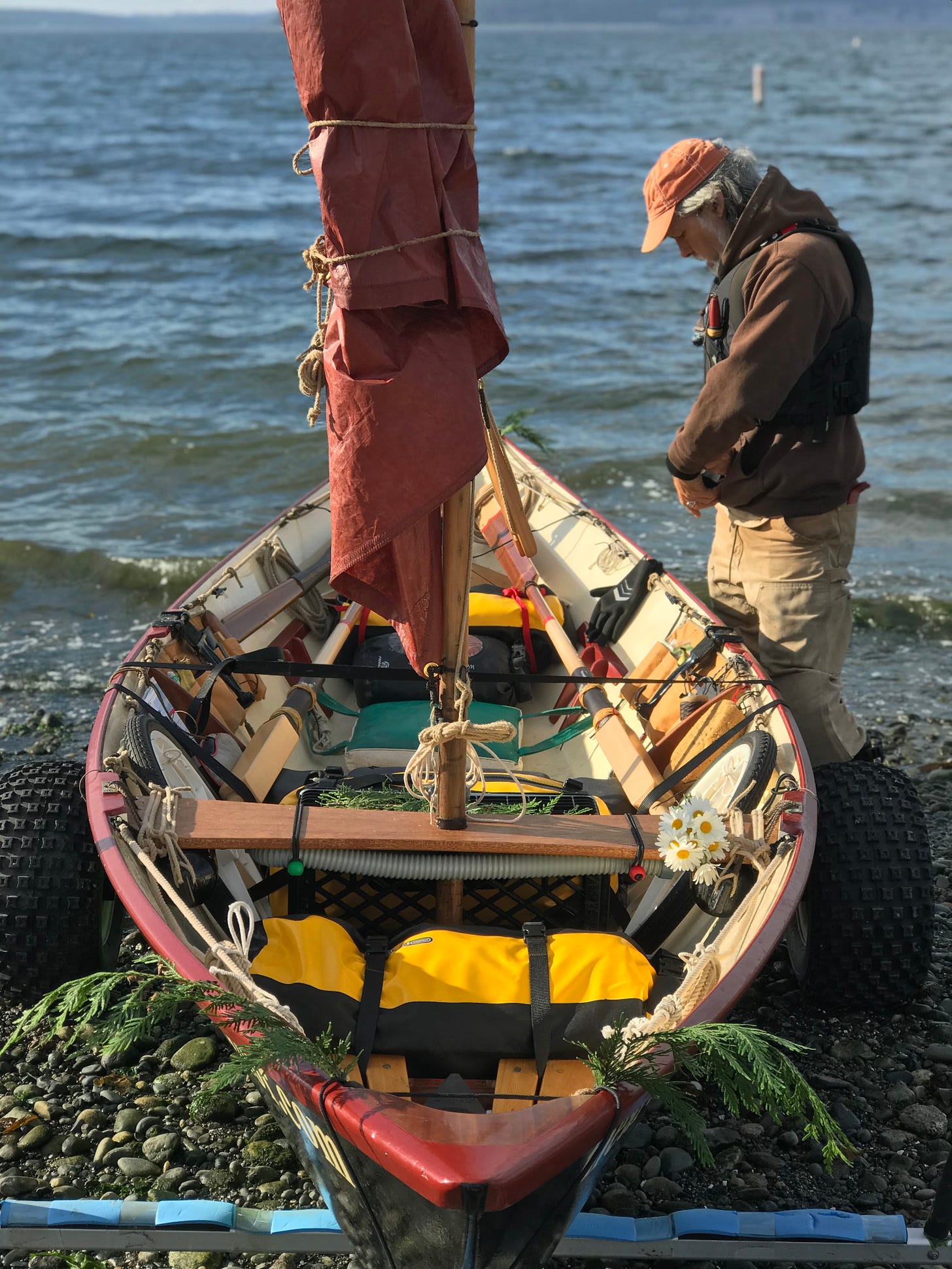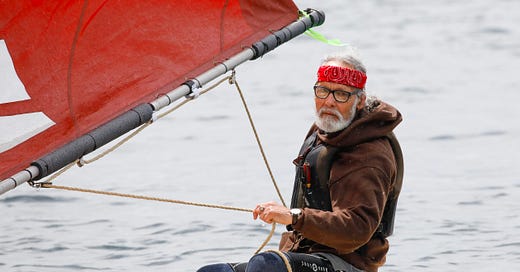When it comes to traditional nautical skills—things like sailmaking, rigging, knots, and all things marlinspike, there may be nobody as knowledgeable as longtime SCA columnist (Artful Sailor) Emiliano Marino. Emiliano quite literally wrote the book on the topic when he penned The Sailmaker’s Apprentice, the enduring instructional text on designing, making, and repairing sails.
We hadn’t talked to Emiliano in a while so we reached out to him with a few interview questions. We think you’ll enjoy his thoughtful answers. —Eds
Tell about your early boating and sailing history. Where and what types of boats did you first sail?
Thanks for having me aboard Josh. I learned to sail as a small child on Cape Cod, Massachusetts in small wooden boats with cotton sails and no motors. Boats were Beetle Cats, Wianno Jrs., Wianno Srs. and the early Sailfish board boat. I was raised by a family with a rich maritime history and my sailing on Bass River and Nantucket Sound was completely influenced by those traditions and heritage.
We know you as someone who likes traditional ways, doing it yourself, simplicity and self-reliance—was this innate from a young age or did you come to appreciate these things later?
I certainly brought my own aptitude, proclivities and sense of aesthetics to an already nautical environment that fostered a New England sense of independence and self-reliance. As time went on, and I gained more experience and went on to maritime trades, my perceptions and investment in traditional practices deepened; partly because I became aware of rigging and sailmaking practices historically and globally.
What’s an example of something boating-related where the traditional or historical version is arguably better than a more modern version or method?
There can be no question about the importance of sailmaking and rigging techniques that are durable and that a sailor can maintain and repair themselves. The current popularity and trends towards mechanical installations and a reliance on auxiliary motors are risky and entail a higher cost. In some applications, light duty fittings will suffice; but, have no place aboard a boat where survival may be a concern. I’m not a fan of spur grommets, pressed-in hanks, roller furling and reefing and various production sailmaking techniques. Currently popular sail fabric looks and sounds to me like a potato chip bag. It is possible, though, to use contemporary synthetic materials in traditional ways and get the best of both worlds.
How about the opposite? There must be some modern sailing or boating gear or conveniences you think are worthwhile.
Yes. As I was saying about the use of contemporary materials in a traditional manner, Dyneema rope has marvelous potential for replacing wire in rigging and sails. Then electric auxiliary propulsion, though not a substitute for good seamanship and sailing, is at least a step beyond the drawbacks of internal combustion engines.
In singer-songwriter Don Edwards’ song Coyotes, the protagonist laments all the change and advancing civilization. One verse goes like this:
Well he cursed all the roads and the oilmen
And he cursed the automobile
Said, "This is no place for an hombre like I am
In this new world of asphalt and steel."
Then he'd look off someplace in the distance
At something only he could see
He'd say, "All that's left now of the old days:
Those damned, old coyotes and me.
How do you regard new technology generally and the rapid changes related to sailing?
Well, there you have an aspect of technological evolution that particularly troubles me. The loss of traditional seafaring terms and designations with new technologies: not only do people not know how to do many things without electronic assistance, but they no longer have the language or the comprehension of how things were formerly done. Navigation is a good example. I find that, generally speaking, many sailors don’t even know sailing terms, the parts of their boat, sails and rigging; it’s all become dumbed down and lacks the definition for efficient communication. Is this a problem? Yes. It’s a problem, particularly so when teaching young people. Certainly, language and nautical terminology evolves with time, technology and usage, some terms do actually become obsolete.
What are a couple of favorite knots? How about one that should be better known?
There are many knots, hitches and bends that I use regularly, but for their exceptional and multipurpose uses, I highly praise the constrictor knot and the rolling hitch, real life savers.
What’s a pet peeve of yours in terms of seamanship or sail handling—maybe something you see beginners do wrong?
I am not as disturbed by a nozzer’s floundering around as I am by experienced people doing unsafe and counterproductive things on the water. I have to say that most of that lubberliness can be traced to a motor-oriented dependency, pace and mentality; some of which has to do with ignorance but in great part has to do with fear. Sometimes people don’t seem to be fearful enough or at least respectful enough, aware enough, of the conditions and temperature of the water here to wear a PFD.
Do you view outboard motors favorably, as necessary evils, or as something to be avoided?
All I can say is, I’ve never needed one and I recommend learning the skills and the alternatives; the rewards are many. It still comes down to: are you able to survive if the motor fails, or if there’s no fuel for it?
We’ve heard a lot of positive talk about yulohs over the years but almost never see anyone using them as their primary or secondary propulsion. Are they better than most people know? What are the pros and cons?
If you jump in the way-back machine, you’ll see that I wrote a couple of articles for SCA about yulohs. Yulohs are enormously useful on the right craft, in the right conditions and they can completely replace an outboard motor. You probably don’t see them that often here because of the dominance of motor mentality. In Southeast Asia, yulohs are everywhere. There are skills involved in making rigging and using a yuloh; but, all in all, it’s rather simple. It could be a problem finding a place to store a yuloh on board so that it is handy and can be quickly deployed; but, there are even collapsible yulohs. Another problem is that marinas, which are essentially motorboat parking lots, are so confined that it is difficult to yuloh your way in and out if there’s too much wind in an unfavorable direction. Certainly, most SCA-type boats could use a yuloh.
What’s a small boat (under 5,000 pounds) design you especially like?
At the moment, I am getting a lot of satisfaction and enjoyment out of sailing a wooden Sunfish. I’ve also rowed a Gloucester Gull dory long distances. There are so many considerations and compromises, it’s hard to say. I do like the Marshall line of cat boats and some of Sam Devlin’s designs. Most of the designs that really make my heart skip a beat are wooden and older. About as contemporary as I get is plywood and synthetic skin on wooden frame.

When people speak of a boat’s “sailing performance” do you think they’re too often focused on speed and pointing ability and failing to understand a boat or rig’s other “performance” strengths?
I’ve long thought the term “sailing performance” to be just about meaningless, especially when comparing nautical apples and oranges, and you’re right, speed in a racing orientation dominates nautical design and manufacturing. That’s one of the reasons why I wrote my book, The Sailmaker’s Apprentice, to provide an alternative point of view and to foster an awareness of multiple factors when defining “performance” of a boat. Look, for example, at the crab claw rig in ancient South Pacific mariners: fantastic sailing performance and achievement for millenia... or the Chinese lug rig, the same; untold types of rigs and sails that evolved to perfection for what they were intended to do with the materials available. So, in answer to your question, yes.
What are your favorite small-boat rigs?
With the exception of the crab claw rig, all my favorite sails and rigs are four-sided, lugs’ls of various description, sprits’ls, squares’ls and gaff headed sails. As time goes on, I am increasingly interested in simplicity and ease of handling.
Tell us about the Artful Sailor and what you’re up to these days. Where can people find out more?
The Artful Sailor was founded by me and Salty Sue 7 ½ years ago upon the principles espoused in The Sailmaker’s Apprentice. We continue to provide workshops, make sails, do repairs, have a used sail program as well as maintain a new and used chandlery of sail and rigging related goods and tools, that are also oriented around those principles. The best way is to hie on over to the shop and take a gander and a whiff in this living museum, or one can get quite an eyeful by going to our website: www.theartfulsailor.com We like face to face or voice to voice, real connections. Tangible and sensory experiences and interaction.
Good talking with you. Smooth sailing in health, harmony and peace. •SCA•





I have pruned my substantial stash of sailing / cruising books down to a handful. "The Sailmaker's Apprentice" is still in my possession (along with Brian Toss's "The Riggers Apprentice"). The brilliance of the book was introducing the reader to many techniques by having them constructing a ditty bag by hand. No sewing machine. I still have mine 25 years later. Even with the crooked stitches and rough hemp rope I will not part with it.
The only disagreement I would have with Mr. Marino concerns roller reefing headsails. I've done both - hanked on and furled. The modern units are pretty bullet proof. For many of us there is only one sailor on board for family outings. Being able to reduce sail in less than a minute from the safety of the cockpit is a godsend. My last keelboat, a Tartan 34C, came with hanked on sails. When it came time to buy new sails I put in a roller furler. For boats over 30ft roller furling is a viable safe option.
For my Phoenix III sail and oar dinghy I plan to make a headsail this winter to pair with the balanced lug. I've already pulled out the "Sailmaker's Apprentice" and perused the relevant section titled "Tensioning the Internal Luff Rope of a Sail Set on a Stay or Set Flying."
The traditional designs we grew up with performed well over a wide variety of conditions, and always brought you home. Anything can be made faster, but can you repair it your self, and will it still serve when the shit hits the fan.